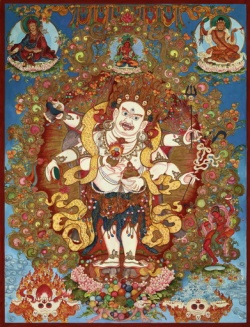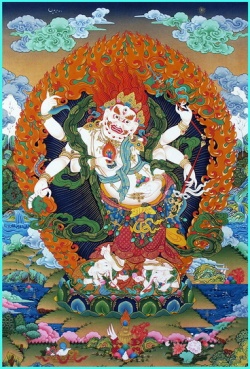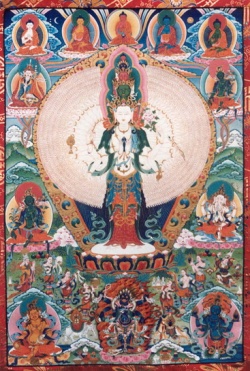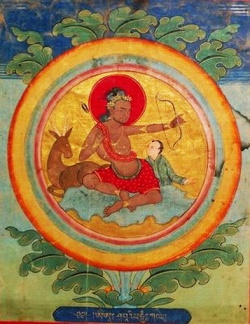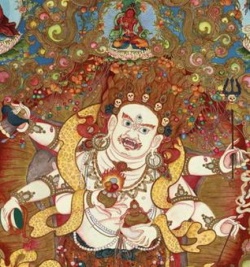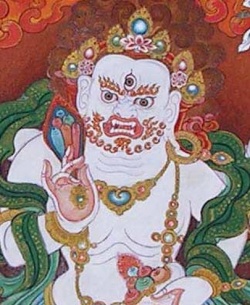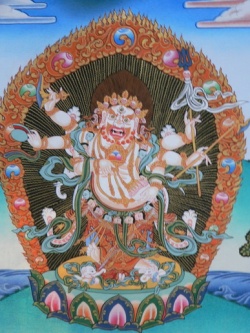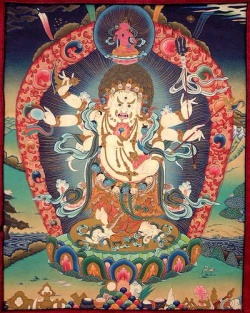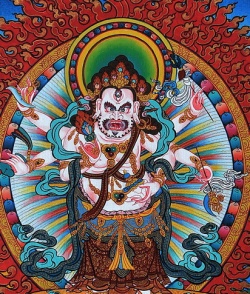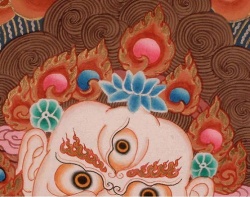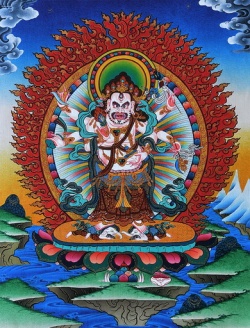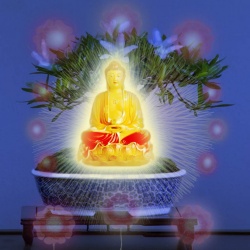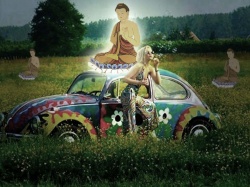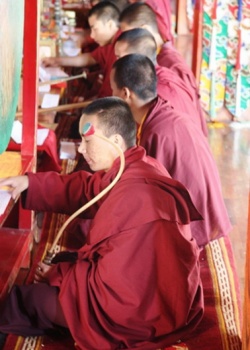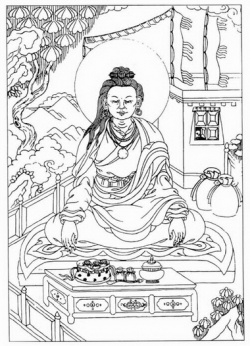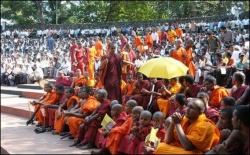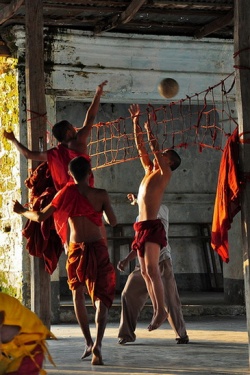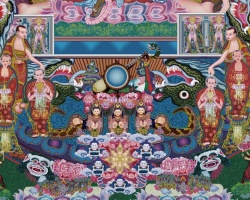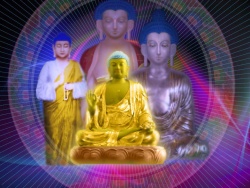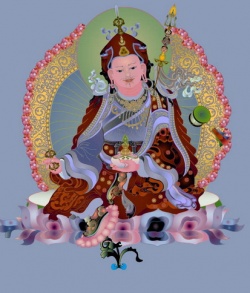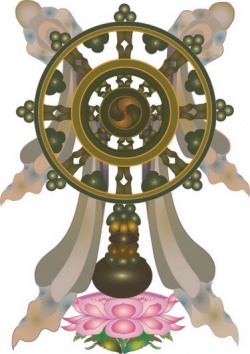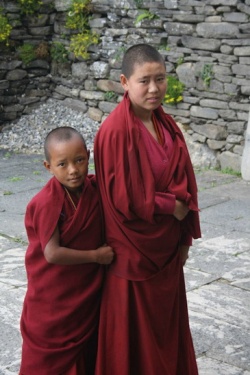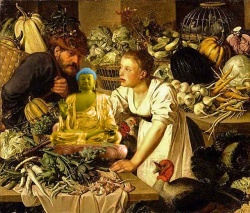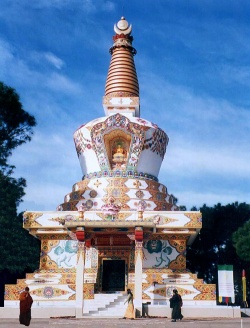White Mahakala
WHITE MAHAKALA is a wrathful (compassionate ferocity) aspect of Avalokitesvara (Chenrezig). Through his compassion, White Mahakala eliminates spiritual and material poverty for all beings, bringing us abundance. WHITE MAHAKALA'S mantra is:
OM GURU MAHAKALA HARI NI SA SIDDHI DZA
If you saw someone drowning, what would you do?
If you knew lifesaving, you might jump in the water and immediately try to rescue them. If you could not swim, then you might throw them a life-preserver, attached to a rope. If you could do neither one of these things, then perhaps you would call for someone to help. You would not whisper, but you would shout as loudly as you possibly could. You would try to do something.
Or, would you just stand there, silently, and watch them drown?
-- -- -- -- --
I may be criticized for doing this, but now I will write about White Mahakala: mGon dkar yid bzhin nor bu: the Rapid Acting Lord of Pristine Awareness, the Jewel, King of Power. Specifically, I will write about his brief daily practice.
There are traditional ways of doing this, but herein is not one of them.
I do not know lifesaving, I cannot swim, and I do not have a rope. But when I look around, I feel that I must do something. So, I am earnestly and loudly calling out. Having many times personally received and experienced the benefit of profound compassion throughout an endless succession of lifetimes -- just as you have -- maybe this is the very smallest thing I could do.
Origin of Mahakala
An inconceivably long time ago, Avalokitesvara gave rise to bodhicitta. As eons passed, he reached the tenth stage of a bodhisattva, and vowed to remain in samsara in order to liberate beings from suffering.
"If ever I break this vow," he said, "may my body break into a thousand pieces."
Still more eons passed, during which he engaged in continuous activity on behalf of all sentient beings, to vouchsafe their liberation. However, there came a time when his clairvoyant understanding of things as they seem caused him to think that his efforts were all in vain.
That moment of doubt was sufficient to break his vow, whereupon his body shattered.
Immediately perceiving a bodhisattva in great distress, Buddha Amitabha appeared and reassembled the pieces into the eleven-faced thousand-armed form of Avalokitesvara we all know today.
Buddha Amitabha counseled Avalokitesvara: "You must make an even stronger vow this time!"
A stronger vow? How could such a thing be possible? Stymied by the vast challenge, Avalokitesvara fell into a swoon that lasted for seven days. When he regained consciousness, he did so with the idea that by appearing in a wrathful form, he could train sentient beings, protect sentient beings, and provide for sentient beings.
His idea was quite straightforward: he decided to accomplish this three-fold activity simply by granting wishes.
This vow crystallized in his heart as a blue-black syllable HUNG, which transformed into Mahakala, empowered with the body, speech, mind, qualities, and activity of all the Buddhas of the three times.
Origin of the Teachings and Practices
So, that is how it begins.
There came a time, when Avalokitesvara was visiting a town in India called Rajastan, when he encountered a dancer, in whom great faith was spontaneously born. Because of devoted offerings to Avalokitesvara, the dancer came to reincarnate as a human named Shavaripa: Master of the Solitudes. This happened six hundred years after Buddha passed into nirvana, or around the beginning of our common era. Shavaripa stayed in the famous charnel ground called Cool Grove, engaged in meditation. One day at dawn, a damaru drum sounded in the sky, and Mahakala appeared. He offered Shavaripa his heart mantra and all his practices, included among which was the practice of White Mahakala.
A thousand years passed, until one day a yogi named Maitri Gupta was compelled by prophesy to visit a place called Mount Glory. Upon doing so, he encountered Shavaripa, from whom he received teachings. Thereafter, he was able to directly communicate with Avalokitesvara himself, and in response to his heartfelt prayers, there has been an emanation of Mahakala in Cool Grove charnel ground ever since. Thereafter, it happened that a fellow named Rahula became rather disgusted with his life, and decided to go to the graveyard and just wait for death. Maitripa came by, encountered Rahula, and heard his story. He then offered the sadhana of the Wish-Fulfilling Jewel Mahakala to Rahula, saying that it could result in siddhis in as brief a period of time as one month or one year.
Practice Lineage
So, the practice I am going to discuss originates with the Indian Mahasiddha Rahula, who received it from his guru, Maitripa. Whether or not Maitripa received this from his guru, Shavaripa, I simply do not know, but it seems likely.
In turn, Rahula gave this practice to the Tibetan Mahasiddha and Shangpa Kagyu lineage master Khyungpo Naljor (978-1129), from whence it passed to Mokchokpa Rinchen Tsondru (1110-1170), Kyergangpa Chokyi Senge (1143-1216), Rigongpa Sangye Nyenton (1175-1247), and then to Sangye Tenpa Tsondru (1213-1285).
From Sangye Tenpa I have never bothered to trace the lineage with absolute precision, but I can say it is highly probable that it passed through Thangtong Gyalpo, and in some fashion -- perhaps through the Karmapa -- reached Tsongkhapa (1357-1419), from whence it passed to the lineage of the Dalai Lamas. Indeed, with the Third Dalai Lama (1543-1588), White Mahakala became the protector of Mongolia. From Thangtong Gyalpo, it is likewise probable that the lineage also passed through Je Drolchok (1507-1566), and Taranatha (1575-1634).
I have not followed the thread in the 17th and 18th centuries. My knowledge of it resumes in the 19th century with Jamgon Kongtrul Lodro Thaye (1813 - 1899), and Jamyang Khyentse Wangpo (1820-1892). In the 20th century, it passes to Jamgon Khyentse Oser (1904-1953), and finally to the Shangpa lineage holder, Dorje Chang Kalu Rinpoche (1905-1989).
Transmission in the 20th Century
Kalu Rinpoche introduced this practice to America and Taiwan 20 years ago, in a series of empowerments held in several different cities.
The circumstances were quite remarkable. Every place he gave the empowerment and every person who attended received a continuous rain of tangible benefits for years afterward. The sphere of influence extended not only to involved individuals, but also to entire regions.
Two decades ago, the future in these places may have seemed uncertain; yet, today, these venues have become centers of Dharma practice, culture, social tranquility, and economic prosperity. This is a testament both to the efficacy of an uninterrupted lineage practice, and the limitless beneficence of a living bodhisattva. No mere words can describe the extent of ]]Kalu Rinpoche's]] manifest compassion and generosity --- he was Mahakala.
I was there, and I saw with my own eyes. He became absolutely indistinguishable from White Mahakala. So, we arrive at this point with the idea that Mahakala begins with Avalokitesvara's compassionate vow to grant wishes, and that the practice of White Mahakala exists in an unbroken lineage direct from Avalokitesvara himself.
The thing to do now is investigate why we are interested in this practice.
Many people are interested in solutions to problems arising from perceived differences between intrinsic desires and extrinsic appearances in three areas: personal wealth, personal relationships, and personal health. For example: some who approach Tibetan Buddhism develop an interest in wealth deities such as Dzambala, magnetizing deities such as Kurukulle, or life-extending deities such as White Tara.
Such people candidly want money, love, and a long, healthy life, and they believe by cultivating this or that deity they will achieve their goals. For them, Buddhist practice becomes a type of sympathetic magic. Their prayers become desperate entreaties to beings they come to identify as gods. They believe that gods grant wishes if properly supplicated. They come to lamas in order to learn such proprieties and they acquire whatever supports they think are necessary.
I am not saying this is wrong, I am not saying this is right, I am not making any judgment about this at all. I am just saying this happens.
It is my personal belief that the loving kindness, generosity, and exquisite care extended by buddhas and bodhisattvas toward all sentient beings in the six realms are without any limitations or conditions whatsoever.
I do not think buddhas and bodhisattvas discriminate between beings based on who prays the loudest, or who has the most beautiful altar, or who gives the most elaborate offering.(*)
The prayers, altars, and offerings are expressions of our own kindness, generosity, and care. The deities of health, wealth, and influence personify the qualities that we, as Buddhists, have an absolute duty to first emulate and then, as we spiritually mature, ultimately embody.
The great beauty of Tibetan Buddhist practice is that it works. In the initial stages, we may come to these practices for entirely selfish motives. Ultimately, we will abandon the selfish component of our thoughts. This will happen naturally, after we wear ourselves out with our experiences.
Instead, we will take as our personal goal the happiness and welfare of all sentient beings. Then, as we perform the Sadhana of White Mahakala, our thoughts will be of others. When we ask Mahakala to assist us, it will only be to the extent necessary to enable our service to others. We will begin to appreciate what this practice really stands for, and any self-absorbed artificiality will dissolve of its own accord.
In many countries around the world, there are government lotteries. The winners receive great sums of money—sometimes tens of millions of dollars.
Naturally, such lotteries excite the desires and imaginations of many people. The conventional thinking is, “Oh, if only I could win, I would build beautiful temples for Buddha and help all the poor people.”
Most would consider this an altruistic motive, and they might pray to White Mahakala on this basis, entering a type of bargaining process with the deity, saying, “If you do this, I promise I will do that.”
Do I need to tell you it does not work this way? The genuinely altruistic act is to do whatever you can; right this minute, for the welfare of beings. The genuinely altruistic thought is, “May everyone receive their heart’s desire.” That is what we are really saying when we perform this practice.
When we ask for something for our companions, and ourselves, we are intending that the entire Sangha receive that which is necessary to actualize the assistance of all sentient beings.
We do this because we understand that poverty is one of the occasions of suffering, and we therefore wish to eliminate the cause of poverty. We understand that the causes of poverty are avaricious thinking, and miserliness, whereas the causes of surplus are altruistic thinking, and generosity. We therefore employ this practice to turn our minds away from greed and avarice toward moderation and munificence.
If you ever have the opportunity to travel in remote areas where people practice Tibetan Buddhism, you may find people who are quite poor by any standard. You can see this in parts of Siberia, Mongolia, and Tibet.
Yet, even in the most humble home—in a nomad’s ger, for example—you will find altar fittings of the finest silver and gold. Often, a family will save for many years in order to provide these, enduring personal sacrifices, and even hunger.
This is not because the deities demand silver and gold. This is not a matter of impressing guests. This is not because the practitioner expects something in return. Rather, this is a reflection of the practitioner’s inner relationship with the sacred. This is a measure of the practitioner’s inherent respect, and even generosity.
The practitioner is saying that her circumstances may be humble; nevertheless, she unconditionally dedicates the surplus riches she has managed to accumulate to all sentient beings. In one sense, she accomplishes this through the medium of the deity, who has powers greater than her own. She asks the deity to help her practice generosity in the very best manner.
although most of us enjoy great material comforts, it seems that we do not rise to the level of our seemingly less fortunate brothers and sisters.
In the developed nations, we often take a rather narrow view. For example: we see an image that costs $200, and another image of the same deity that costs $2,000, and we automatically begin a subliminal dialogue: “Why should I pay $2,000 just to make somebody else rich? That $200 image will do just as nicely.” We start bargaining again. We become caught in the numbers. We think we are saving money. However, we fail to understand that this sort of thinking leads to poverty.
all images are nirmanakaya. all images are equal. Price, and even workmanship, is utterly unimportant. What is important is our relationship to the sacred.
Our spiritual friends, such as our teachers, can introduce us to the sacred, but after that, maintaining the relationship becomes our responsibility.
We want to enlarge the space that the sacred occupies in our lives. We want to erase attachment and aversion. The task becomes simple: honestly doing the best we possibly can. Maintaining any sort of relationship takes effort. We cannot allow lazy mind to defeat our progress.
Sometimes we develop an angry, impatient relationship with our practice. Here we sit, repeating this or that mantra so many times. Why does it have to be ten times? Would not eight times do just as well? Why cannot we finish the whole thing right now, so we can go about our business?
If this happens to you, use it for your benefit. ask yourself what it is you would rather be doing, and why. Examine the source of your impatience. Examine the source, content, and object of your anger.
Why are you angry? What does this anger consist of? Where is this anger directed?
Examine all the times you have been angry and impatient in the past. Remember the outcome. ask yourself why this time the outcome might be any different.
When your hand clenches so tightly, learn how to effortlessly open your hand. Just drop whatever you are holding. This, too, is a form of generosity. You extend this generosity to yourself.
You must approach the practice of White Mahakala with an open hand, a generous spirit, and a liberal mind. These qualities must be firmly rooted in compassion. Compassion is what drives the entire practice. White Mahakala is in fact manifested from the heart of avalokitesvara, the Bodhisattva of Compassion.
If you are able to develop genuine compassion for others, and if you make this the foundation of your practice, then even if you cannot accomplish the visualizations or complete the mantras, your practice will bring results.
Please have confidence in this. The hours you spend in confident practice are the best hours of your life.
The practice of White Mahakala begins with the three acts of taking refuge, developing motive, and reciting the Four Immeasurables. These acts are called “preliminary,” simply because they are performed before visualizations, offerings, and so forth. This does not mean, in any fashion, that they are mere formalities to be quickly dispensed with before beginning real work. In many respects, these three acts are the heart of the practice. In my view, any deficiency, neglect, hesitation, or equivocation in these will render the rest of the practice ineffective.
We repeat each of the acts three times. Apart from any symbolism involved, we are giving ourselves the opportunity to deeply consider what we are doing and why we are doing it. We should use this time to ask ourselves if we really mean what we say: if the words we recite truly reflect our core beliefs.
If we find that we can act honestly, from pure motives and a genuinely compassionate heart, we proceed to visualize White Mahakala, believing that he is before us. Actually, White Mahakala is always available to us. He instantaneously appears from the emptiness that is no different from our own mind. However, in this instance, we decide that he comes before us, manifesting various probative attributes and particular characteristics.
His imagery is not just for the purpose of a pretty picture. His imagery is symbolic of certain qualities that we must contemplate in order for our practice to be meaningful: a kind of visual onomatopoeia, if we may say.
Although this imagery is rooted in the ancient culture of India, it reflects basic human concepts, and is thus still of benefit once we appreciate the underlying symbolism. Fundamentally, this is a way of expressing White Mahakala’s essence.
The six-armed White Mahakala is a deity of the wrathful class, and he bears accouterments usual to that class. These may be considered individually and collectively. The chopper (gri gug) he holds aloft is used to sever and mince the life veins of enemies of the Dharma. The chopper also symbolizes severing conceptualization. He holds the precious wish-fulfilling gem yid bzhin nor bu to his heart. This shines with lights of five colors, signifying the Five Buddha wisdoms.
The double-headed hand drum summons all the Buddhas of past, present, and future, filling them with bliss. If you like, you can say that White Mahakala is setting a certain rhythm, or energy. You can also say that his drum symbolizes relative and absolute bodhicitta. The skull-cup (kapala) in his left hand contains a vase of jewels in a sea of nectar, symbolic of the wealth that arises from method. This is not necessarily material wealth; rather, the wealth arising from the union of wisdom and means. We say this because he tramples on two Ganesh, who are each holding a mongoose, and these are typically considered evocative of material wealth.(*) He is saying, “Behold! I have a treasure that surpasses ordinary treasure!”
Nevertheless, the treasure vase in his skull-cup can also be considered emblematic of his ability to bestow material wealth. The trident (rtse gsum) he holds symbolizes the destruction of the three poisons of desire, anger, and delusion. The tangkhas usually depict an iron hook in his remaining hand, but the text quite clearly reads zhags pa, or noose. Both should be understood. The hook symbolizes clear understanding, whereas the noose symbolizes clear recollection. In the present instance, the symbolism may be of binding demons and preventing harm or, in the alternative, binding wisdom to the practitioner’s mind.
Taken collectively, the chopper and skull cup symbolize the union of wisdom and means, and the trident, drum, and skull cup symbolize White Mahakala’s body, speech, and mind. He is attired in a tiger-hide loincloth (stag lpags kyi sham thabs), which symbolizes the transformation of ordinary anger into righteous wrath. On his back, is a freshly flayed elephant-hide (glan po che’i pags pa), which symbolizes overcoming ignorance. A crown of five skulls (thod skam gyi dbu rgyan) adorns him, each skull surmounted by a precious jewel set in gold (rin po che’i rtse phran). These symbolize the Five Buddhas.
So, yesterday we looked at what we might consider threshold iconographic explanations for what White Mahakala holds and how he is attired. This may be important for artists, but perhaps it is not so important for us. If we have the sort of mind that requires such concordances, then we can add to the above list in considerable detail. If, on the other hand, we do not require it, we can dispense with the symbolism and experience White Mahakala as he naturally arises, satisfying ourselves on the level of immediate reality.
Sometimes, I think it is useful to simply call upon the deity and then take note of what he looks like when he arrives. White Mahakala may appear one way at one time and another way at another time. There may come a time when all appearances are White Mahakala.
The Offering
The next matter to be considered is the offering. Primarily we are performing what is known as an inner offering; so called because it is of the inner components of humans and animals. These impure components are transformed into elixir, in order to bless the outer offerings.
Naturally, we do not cook this in an actual vessel. Instead, we visualize this process. If we wish, we can also then symbolize the visualization with black tea or wine in a skull cup.(*) We can place the ring fingers of our right and left hands together and encircle the skull cup three times, setting it to the left side of our table.(**) It is not strictly necessary for us to do this: we can do this entirely as visualization. However, if we find it useful to adopt such formalities, we can use an actual skull cup as noted.(***)
On the altar, we have the external torma, if possible, and the offerings of water and so forth, arranged in bowls. Many people are confused about this aspect of practice, so we will review a few details.
a torma is not an object. An object can symbolize a torma, and we can call that symbolic object a torma. a torma is in fact a space. To the extent that an object symbolizes this space, then that object is a vessel. We want the torma to be free from physical impurities, and want it to be free from conceptual impurities. We therefore understand that the torma arises from emptiness, is an inherently empty, uncreated offering vessel, ultimately devoid of form, and dissolves into emptiness.
We arrange our offering bowls from left to right in the following fashion: in the first bowl, we place pure drinking water. When we offer this water to the deity, we think that it completely and simultaneously quenches the thirst of all sentient beings. actually, we are giving this water to the deity to deliver. White Mahakala is not thirsty.
Next, we offer water for bathing. again, White Mahakala is not dirty, but rather serves as the medium to wash all sentient beings clean of their defilements.
We next offer flowers, and the surroundings of all sentient beings become beautiful by this action. We offer incense, which similarly soothes and beautifies the surroundings of all beings, cleansing the air.
Next, we offer light, eliminating the darkness of ignorance. We follow this with perfume, which purifies the stains of immorality.
We now offer food, bestowing freedom from deprivation, followed by music, which purifies all sound.
allowing for the above, you should understand that this practice might be done in the middle of traffic, if you have the mind for it. There are all sorts of things that nobody owns, such as wildflowers, or the songs of birds. There are pure waters in mountain springs. There are delicious fruits growing wild in the fields. You can offer all of these, and all the other treasures your mind can conceive.
The point is that you are giving these offerings to White Mahakala, who in turn is delivering them to all sentient beings. Therefore, you can afford to be creative. For example: when you give light, you can specify that it bring light to those who are blind. When you give music, you can believe that it removes harmful or fearful words. When you give food, you can understand that beings will ultimately be delivered from reliance on external sources. The possibilities are as endless as you wish. The corresponding benefit is inconceivable to the human mind.
The next matter to consider is that of supports. When you are concluding this practice, you can invite White Mahakala to stay in a picture, or a statue. This is up to you. It is my idea that White Mahakala is inherently present in pictures of my teacher. You may find that he is inherently present in pictures of your teacher.
We should also discuss the mantra. White Mahakala’s mantra has thirteen syllables. Were you to recite the mantra 100,000 times, this would represent 1,300,000 syllables. This cannot hurt anyone. as to the appropriate mala for counting this mantra, it is considered traditional to use 108 lotus seeds, or bodhi seeds, or even 60 rudraksha tree berries having specific characteristics. actually, any mala with 108 beads of any material will be just fine. We must learn not to be neurotic about such matters.
Finally, we dedicate the merit gained by our actions to the welfare of all sentient beings. We hope that it will become a source of benefit to them and never a source of harm. Under no circumstances do we keep any merit for ourselves.
click to hear White Mahakala (8.3 MB mp3)
Tomorrow -- which is a "ten million" day -- we are going to conclude this five-part post with the actual practice: Sadhana of the Rapid Acting Lord of Pristine Awareness, the Jewel, King of Power (mgon dkar yid bzhin nor bui sgrub thabs bsdus pa bzhug so).
A few notes are in order.
A novice monk -- a young westerner, from Belgium, for whom English was a second language -- produced the first English translation of this text, which Kalu Rinpoche personally selected. This was done in Alhambra, California, in 1988. The resulting edition was limited to 250 copies, of which no more then five or six survive.
In 2002, Lama Lodro, of San Francisco, California, published an expansion of the original text under an identical title, with a lightly revised English translation. One suspects this edition was also limited.
Although I know of several attempts -- including an earnest attempt by my wife, assisted by myself, and Patrul Rinpoche's Taiwanese translator -- I do not know if a satisfactory translation into Mandarin Chinese has yet been produced.
There is also a Sakya version, given out at the Sakya empowerments, in both English and Mandarin. I have examined them both.
I did an abbreviated English text with phoenetic Sanskrit in 2007, in support of an empowerment given by the Ninth Ogyen Tulku (Ogyen Gyurmed Wanggyal Rinpoche) in Alhambra, California -- very close to the one I will present here as Part 5 of our series.
I want to add my hope that this series has been of some benefit.
Empowerment Necessary
I will tell you quite candidly that it would be not entirely appropriate to attempt this practice without the associated empowerment.
However, I fully understand that your circumstances may be such that you have little hope of receiving such empowerment. For example: you may live in a far off place, where lamas never wander. You may have limitations that prevent you from traveling to receive the empowerment. Maybe you know a lama, but he has not accomplished this practice and so cannot give the empowerment.
A khenpo that I respect very much -- Khenpo Karthar Rinpoche -- has written about this issue, and I like his approach:
"Some people try to practice without having received empowerment or lung. Without these prerequisites -- or if their practice is incomplete -- though there may be some blessing, it will not be as effective. And certainly all aspects must be complete in order to attain any kind of realization."
If you require a particular empowerment, and if your motivation is pure, it has been my experience that you can practice the deity's mantra as a form of request. You are in essence telling the deity you want to engage in the practice, and that you desire a connection, but you lack the empowerment. For example: after accumulating 100,000 mantras, it often happens that the necessary conditions suddenly materialize.
This really depends upon your sincerity and the purity of your motivation. If your motivation is absolutely pure, the deity himself will come and bestow the empowerment -- but, most people seem to think that is very rare. Even if it isn't as rare as people suppose, there is always our capacity for self-deception to consider. We may deceive ourselves that the deity has bestowed the empowerment, when in fact nothing at all has happened.
So, really, to remove all doubt: the best thing is to create the conditions that make it possible for you to receive the empowerment.
Did I tell you?
White Mahakala grants wishes.
Brief Daily Practice of the Rapidly Acting Lord of Pristine Awareness,
The Jewel, King of Power
1.Preliminaries
Thought of Refuge (repeat three times)
From this moment on: until attaining complete enlightenment solely for the benefit of others, I, together with all sentient beings of the Six Realms, continuously take refuge in the Buddha, Dharma, and Sangha; the Lama, Yidam, and Dakini.
Shaping of Motive (repeat three times)
Through the practice of generosity and other virtues, may I attain buddhahood in order to help others.
The Four Immeasurables (repeat three times)
May all sentient beings have happiness and the causes of happiness; may all sentient beings be free from suffering and the causes of suffering; may all sentient beings never be separate from the genuine happiness that is free from suffering; may all sentient beings abide in equanimity that is free from passion, aggression, and prejudice.
2. Visualization
om shunyata jnana bedzra sobhawa atmako nya ham
all things and I are the nature of that indestructible wisdom that is emptiness.
[With this mantra, all appearances are refined to emptiness.]
From empty space, a circle of protection comes from HUM. In its center a lotus appears from PAM, above it a sun from RAM, and from GAM, two Ganesh, white, with elephant heads, each holding a radish and mongoose, lying face down.
Above them, one’s mind appears as two vital drops of pure being, both white and red together, the size of a pea.
In the center is HUM, the color of quicksilver. From them, light shines, clearing away the suffering of all sentient beings that poverty causes.
The light is drawn in again and absorbed and the drops change to become the undifferentiated front and self generation, the forms of the Fast-acting Lord of Pristine Awareness, the Jewel, King of Power.
He is white in color and shines brilliantly. His face is wrathful with a smiling expression, full of humor. He has three eyes. His eyebrows, beard, and hair are orange and flaring.
His forehead is marked with a cinnabar triangle. Above his head, King Akshyoba seals him.
His first right hand brandishes a chopper in the sky. The middle hand holds the precious wish-fulfilling gem to his heart. The last right hand rattles an acacia wood hand-drum.
The first left hand holds by his left thigh a skull-cup filled with nectar in which there is a vase filled with jewels, in the second hand there is a trident, and the last left hand holds a noose.
He stands on the seat of the lotus, sun, and two Ganesh with his feet in the position of preparing to move.
He wears flowing silks of different patterns, a tiger-hide loincloth, and on his back, a freshly flayed elephant-hide mantel. He is adorned by a crown of five skulls, each surmounted by a precious jewel set in gold; a garland of fifty freshly severed heads, dripping with blood; ornaments of jewels; jingling bells, and garlands of flowers.
Surrounded by throngs of hundreds of millions of power-gathering dakinis as attendants, he stands in the center of a mass of flames.
At his forehead, there is a white OM, at his throat a red AH and in his heart a red power-gathering dakini holding an elephant goad and a skull-cup filled with blood. At her heart is a vital drop of pure being and at its center a white HUM.
From one’s own heart, light shines out inviting the Fast-acting Lord of Pristine Awareness, the Wish-Fulfilling Jewel, and all his throngs of dakinis from the Cool Grove Cemetery in the Southeast. (bell)
3. Accomplishment of the deity
pema kamala ya sa tam
dza hung bam ho
om bedzra argham ah hung
om bedzra padyam ah hung
om bedzra pukpe ah hung
om bedzra dhupe ah hung
om bedzra aloke ah hung
om bedzra gendhe ah hung
om bedzra newidye ah hung
om bedzra shabda ah hung (*)
Lord of pristine awareness, compassionate one: your body is white, radiant with light, like a snow-covered mountain. You completely pacify the poverty of beings. I pay homage and praise you. Grant me the attainment of numerous desires.
4. root mantra
GURU MAHAKALA HARI NI SA SIDDHI DZA
(repeat 1,008 times, or as many times as possible)
5. torma offering
(cleansing mantra of Trowo Dutsi Kyilwa)
om bedzra amrita kundrali hana hana hung pe
(purification mantra)
om sobhawa shudha sarwa dharma sobhawa shudho ham
Out of empty space, wind appears from YAM, fire from RAM and above that, a skull-cup from AH. It is completely filled with the five meats and the five elixirs all marked by the syllables HUM, BHRUM, OM, JRIM, and KHAM. (**)
The wind blows, the fire blazes, and the ten substances and letters melt.
Elixir is drawn from the hearts of all Buddhas, and is absorbed into the contents, which become an ocean of elixir of pristine wisdom.
om ah hum ha ho hri (repeat three times)
The assembly of wisdom deities drinks the torma, drawing it in with their tongues in the form of Vajra straws. (***)
guru mahakala ha ri ni sa siddhi dza idam baling ta kaka kahi kahi
Eat, eat, please eat, please eat this torma. (repeat seven times)
om shri mahakala ya sha sa nam|
u pa kari nam|
e ko pash chi ma ka lo yam idam ratna trayaya|
a pa kari nri ya di pratijaña|
samara sita da|
idam duktram kaka kahi kahi|
mara mara|
grihana grihana|
bandha bandha|
hana hana|
daha daha|
patsa patsa|
di na me kena|
maraya hung phat|
idam baling ta kaka kahi kahi|
(repeat above three times)
om bedzra mahakala sapari wara|
argham|padyam|pukpe| dhupe|aloke|gendhe|newidye| shabda|tra tyi tsa hung so ha|
(drum & bell)
Lord of pristine awareness, compassionate one: your body is white, radiant with light, like a snow-covered mountain. You completely pacify the poverty of beings. I pay homage and praise you. Grant me the attainment of numerous desires. Accept this offering and torma. (bell)
To we practitioners and our companions grant good health, life, power, glory, fame, and good fortune.
Grant me attainment in enlightened activity, pacifying, enriching, and the others.
Through your commitment, protect me. Through all attainments, be my companion.
Eliminate premature death and sudden illness, demons and obstacles.
Eliminate nightmares and bad omens, evil activities, and plans.
Make the world happy with good harvests, make crops flourish, and make the Dharma flourish. Grant the best in happiness, and fortune, and everything the mind desires. (bell)
6. hundred syllable mantra of vajrasattva
om vajra-sato samaya manupalaya
vajra-sato day-nopa day-ta dri-do mebawa
suto-kayo mebawa supo-kayo mebawa
anu-rakto mebawa sarwa siddam mepar-ya-tsa
sarwa karma sutsamay
chi-tum shereyang kuru hum
haha haha ho
bagawan sarwa tata-gato vajra mame mun-tsa
vajra bawa maha-samaya-sato ah
In the guru and the lord undifferentiated, I take refuge with devotion. Clear away all emotional confusion in me and all sentient beings.
7. Placing in Support
By staying in this very place, united to this representation, spare us illness and grant us long life and power. Grant us the Sublime Accomplishment in the most excellent way.
May the goodness prevail of the Lama and Yidam, the fulfillment of all fine qualities. May the goodness prevail of the dakinis and dharma protectors, who effect all enlightened activity.
ge way tsok nam sak pa kun
dak gir yong su zung me par
sem chen ma lu kun dun du
che ying la na me par ngo
8. Dedication of Merit
Through this merit may beings, having won omniscient perception, defeat all harmful enemies. May all beings be liberated from the ocean of existence and its surging waves of birth, old age, sickness, and death.
He has a garland of fifty freshly severed heads (dbu bcad ma ‘phreng ba), dripping with blood, symbolizing the purification of speech.
